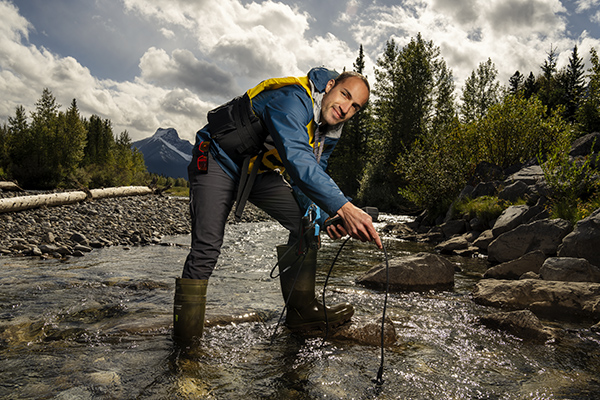Making waves: SAIT students dive into real-world water solutions

Water, water everywhere! It's a compound we can't live without. Yet, as much as we rely on water for our survival, it can also be a source of damage — with flooding wreaking havoc on crops and communities, and scarcity impacting health and survival.
SAIT Integrated Water Management students are starting local with solutions to tackle the threat of flooding damage as well as increasing conservation in landscape use.
Data-driven flood solutions to safeguard Calgary communities
For their final major project, second-year Integrated Water Management students Aidan Yakymyshyn and Dawson Smethurst dove into data to create stormwater improvements for high-risk flooding areas around Calgary.
The City of Calgary's River Engineering team provided Yakymyshyn and Smethurst with four different spatial Geographic Information System (GIS) data sets.
"By combining the spatial GIS data sets, we were able to identify local communities susceptible to potential pipe backups due to flooding," says Yakymyshyn.
Yakymyshyn and Smethurst presented their findings to the City of Calgary team, where the two students recommended stormwater outfall upgrades.
"Using insights from our data analysis, we recommended the city install water flow control devices (valves) in flood-prone areas. The potential cost of damages in the absence of these valves could be three times the cost of installing the valves," says Smethurst.
Taking flight towards sustainable water solutions
Yakymyshyn and Smethurst aren’t the only ones coming up with local water solutions. Second-year Integrated Water Management students Nicole Willment and Parisa Khorsand created sustainable water recommendations for the Calgary Airport Authority and their surrounding tenants of hotels, dining areas and transportation services.
Willment and Khorsand’s goal was to identify ways to reduce the amount of potable water needed for landscaping irrigation purposes.
“Our project deliverables included surveying the Calgary Airport Authority tenants to understand better how they use potable water and complete literature reviews on water reuse options and zero irrigation landscaping practices,” says Willment.
The duo collected enough data to recommend how the airport could update landscaping guidelines for all new developments.
“To minimize potable water consumption for irrigation, we proposed the Calgary Airport Authority enhance its landscape guidelines by exclusively incorporating native and drought-tolerant plant species for all future project developments. Additionally, we advocated for implementing new strategies to gather and repurpose storm and rainwater resources to foster sustainability and conservation practices within the airport,” says Khorsand.

“Leveraging the skills we learned through this program, and working on a water sustainability project with a large company has been an incredible experience. It feels like we’re making a difference,” says Willment.

Integrated Water Management
Are you ready to plunge into the world of water management #HereAtSAIT? Dive into SAIT’s Integrated Water Management program and develop the skills you need to help our communities tackle complex water issues.
Industry Driven
We prepare students for successful careers and lives.
SAIT'S
2020-2025
Strategic plan

Oki, Âba wathtech, Danit'ada, Tawnshi, Hello.
SAIT is located on the traditional territories of the Niitsitapi (Blackfoot) and the people of Treaty 7 which includes the Siksika, the Piikani, the Kainai, the Tsuut’ina and the Îyârhe Nakoda of Bearspaw, Chiniki and Goodstoney.
We are situated in an area the Blackfoot tribes traditionally called Moh’kinsstis, where the Bow River meets the Elbow River. We now call it the city of Calgary, which is also home to the Métis Nation of Alberta.


